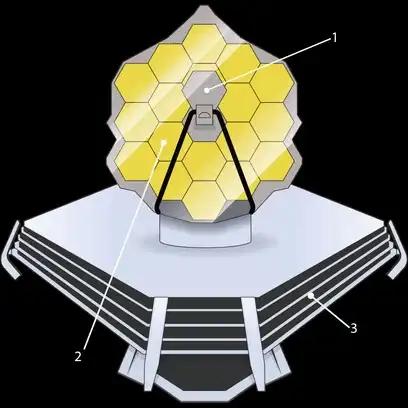James Webb Space Telescope: How does it work and what will it see?
Curated from: sciencefocus.com
Ideas, facts & insights covering these topics:
10 ideas
·1.05K reads
11
1
Explore the World's Best Ideas
Join today and uncover 100+ curated journeys from 50+ topics. Unlock access to our mobile app with extensive features.
The James Webb Space telescope
The James Webb Space telescope will image the little-known places in the Milky Way and beyond. Here are just a few of the things it hopes to see and the tech it will use to see them.
27
382 reads
JWST: The facts
Full name: James Webb Space telescope
Size: 21 x 14m (sunshield)
Launch mass: 6,200kg
Cost to build: $10bn
Launch date: 31 October 2021
Expected first images: 2-3 months after launch
Collaborators: NASA, ESA and Canadian Space Agency
Mission duration: 5-10 years
Orbit: 1.5 million km from Earth
32
112 reads
Top part
- Secondary mirror: Reflects light from primary mirror and focuses it into the Integrated Science Instrument Module (ISIM).
- Primary mirror: 18 hexagonal segments, coated with gold, capture the light from distant celestial objects.
- Sunshield: The size of a tennis court, it protects the telescope from light sources, such as the Sun.
26
93 reads
Bottom parts
- ISIM: The Integrated Science Instrument Module produces images from light captured by secondary mirror.
- Spacecraft bus: Contains most of the steering and control machinery.
- Star trackers: Small telescopes that observe star patterns to help aim the telescope.
- High gain antenna: Transmits data back to Earth and receives commands from NASA’s Deep Space Network.
26
71 reads
The early universe
The JWST will be ale to look back around 200 million years after the big bang, when the first stars in the Universe formed.
The first stars are thought to have been massive giants made of hydrogen and helium, whose short lives ended in the supernovae that created the heavier elements we detect in younger stars today.
To see this period in cosmic history, we need sensitive infrared instruments to detect the faint traces of light that have travelled through space and time to reach us.
30
121 reads
Ancient galaxies
The JWST will also look back to the very first galaxies in universe to learn mor about their evolution and why there’s so much variety in them. Nearly all the spiral and elliptical galaxies that we see today have experienced at least one collision or merger with another local galaxy.
Yet older galaxies look entirely different to their modern counterparts – smaller, clumpier, less structured.
Examining galaxies can also inform us of the macrostructure of the Universe and how it’s organised on a large scale.
26
78 reads
Dark matter
Dark matter is thought to play an important role in the struycture of the universe, accounting for five times the mass of normal, baryonic matter such as atoms and particles. Considered to be the scaffolding for the Universe, we’re only able to observe dark matter indirectly by measuring how its gravity affects stars and galaxies.
The JWST won’t be able to see dark matter, but it will employ gravitational lensing techniques to study the most distant galaxies and look at their rotation for signs that dark matter is at play.
26
54 reads
Exoplanets atmospheres
The JWST will help answer the big question of whether life exist beyond earth by studying a variety of exoplanets - planets outside our solar system
Of particular interest is the TRAPPIST-1 system, where three of its seven planets are in the habitable zone and one may harbour liquid water. The JWST will observe the planet as light from its parent star passes through the planet’s atmosphere, revealing its chemical composition and the gases that are present there.
26
47 reads
Our ice giants
While the JWST's primary science aims lie more in cosmology and star formation, it’ll also take a closer look at a couple of familiar objects – our ice giants, Neptune and Uranus.
The JWST will map their atmospheric temperatures and chemical composition to see how different they are – not only to each other, but also their gas giant cousins, Jupiter and Saturn. The ice giants are at least 30 times further from the Sun than Earth and are the least understood planets in our Solar System.
26
44 reads
Pluto and the kuiper belt objects
Dwarf planet pluto and its fellow Kuiper Belt Objects will also be receiving some observation time.
The JWST is powerful enough to study such icy bodies including comets, which are often-pristine leftovers from our Solar System’s days of planet formation and could hold clues to Earth’s origins. There are no planned missions dedicated to the outer Solar System for years, so new observations and data will play a big part in planning for future planetary missions.
26
54 reads
IDEAS CURATED BY
I'm passionate about helping people live their best lives. I'm a lifestyle coach & burnout coach.
Rogier. H's ideas are part of this journey:
Learn more about technologyandthefuture with this collection
Basic survival skills
How to prioritize needs in survival situations
How to adapt to extreme situations
Related collections
Similar ideas
10 ideas
NASA’s 10 Greatest Science Missions
space.com
6 ideas
1 idea
How the Big Crunch Theory Works
science.howstuffworks.com
Read & Learn
20x Faster
without
deepstash
with
deepstash
with
deepstash
Personalized microlearning
—
100+ Learning Journeys
—
Access to 200,000+ ideas
—
Access to the mobile app
—
Unlimited idea saving
—
—
Unlimited history
—
—
Unlimited listening to ideas
—
—
Downloading & offline access
—
—
Supercharge your mind with one idea per day
Enter your email and spend 1 minute every day to learn something new.
I agree to receive email updates










